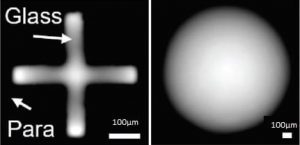For systematic studies in many areas of biological and biomedical research, it is necessary to simulate the in vivo cellular microenvironment in a reproducible, high-throughput manner. High throughput is also required for the immobilization, mixing, transportation and storage of small amounts of liquids suspended on suitable substrates. This requires strict control over the position of droplets and cells within a confined space.
The ability to direct the patterning of liquids and the attachment of cells to a substrate can be influenced by controlling the wettability of the surface; however, techniques currently exploiting surface wettability are not readily compatible with all of the required substrates.
Coating paraffin wax onto hydrophobic polydimethylsiloxane (PDMS) channels is known to prevent certain other molecules from attaching to the PDMS surface. This chemistry led a collaboration between the University of Texas and the National Taiwan University to develop what they call a ‘ParaStamp’. They transferred patterns from a preformed PDMS master onto a commercial Parafilm by pressing the film against the PDMS with a foil and heating it for a very short time. The cooled, patterned film (the ParaStamp) could then be peeled off the PDMS and placed on a variety of substrates, including glass, polystyrene, and foil sheets.
The stamps create hydrophilic regions even on hydropho bic substrates, into which droplets can be confined and incubated, allowing time for cells to adhere.
The researchers demonstrated the use of their patterned substrates for an investigation of the therapeutically relevant selectivity of drugs, a drug synergy screening. Importantly, their array returned the same result for drug dose responses as the standard 96-well plate array.
 Cracked stamps were easily removed from the substrate with the aid of ethanol, and could be either healed or reconfigured upon reheating against the PDMS master, making them fully recyclable. Repeated cycling of one stamp–substrate pair showed the same water contact angles measured even after 14 cycles with different patterns.
Cracked stamps were easily removed from the substrate with the aid of ethanol, and could be either healed or reconfigured upon reheating against the PDMS master, making them fully recyclable. Repeated cycling of one stamp–substrate pair showed the same water contact angles measured even after 14 cycles with different patterns.
Find out how you can apply this technique for your own assays in Advanced Biosystems.

















